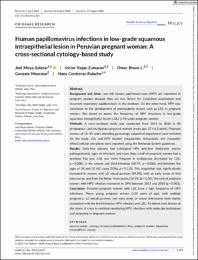Mostrar el registro sencillo del ítem
“Human papillomavirus infections in low‐grade squamous intraepithelial lesion in Peruvian pregnant woman: A cross‐sectional cytology‐based study“
| dc.contributor.author | Moya‐Salazar, Jeel | es_ES |
| dc.contributor.author | Rojas‐Zumaran, Víctor | es_ES |
| dc.contributor.author | Bravo L., Omar | es_ES |
| dc.contributor.author | Moscoso, Gonzalo | es_ES |
| dc.contributor.author | Contreras‐Pulache, Hans | es_ES |
| dc.date.accessioned | 2023-02-10T19:37:18Z | |
| dc.date.available | 2023-02-10T19:37:18Z | |
| dc.date.issued | 2022-08-25 | |
| dc.identifier.uri | https://hdl.handle.net/20.500.13053/7784 | |
| dc.description.abstract | “Abstract Background and Aims: Low‐risk human papillomaviruses (HPV) are important in pregnant women because they are risk factors for Condyloma acuminatum and recurrent respiratory papillomatosis in the newborn. On the other hand, HPV may contribute to the development of preneoplastic lesions such as LSIL in pregnant women. We aimed to assess the frequency of HPV infections in low‐grade squamous intraepithelial lesion (LSIL) in Peruvian pregnant women. Methods: A cross‐sectional study was conducted from 2011 to 2015 in 84 primiparous‐ and multiparous pregnant women (mean age: 27 ± 6.3 years). Pregnant women of 18–45 years attending gynecology outpatient department were included for the study. LSIL and HPV (nuclear irregularities, koilocytosis, and cytopathic effect) cellular alterations were reported using the Bethesda System guidelines. Results: Sixty‐four percent had cytological HPV infection (koilocytes and/or pathognomonic signs of infection) and more than a half of pregnant women had a previous Pap test. LSIL was more frequent in multiparous (increased by 12%, p = 0.008), in the second and third trimester (60.7%, p = 0.002), and between the ages of 18 and 30 (42 cases (50%), p = 0.110). This proportion was significatively increased in women with ≥2 sexual partners (39.3%), with an early onset of first intercourse, and from the Rímac Municipality (14.3%) (p < 0.05). The rate of pregnant women with HPV infection increased by 39% between 2011 and 2015 (p = 0.001). Conclusion: Peruvian pregnant women with LSIL have a high frequency of HPV infections. These young pregnant women (≤30 years of age), with multiple pregnancy, ≥2 sexual partners, and early onset of sexual intercourse were mainly associated with the third trimester HPV infection and LSIL. To detect early lesions of the cervix, it is key to continue monitoring HPV infections with molecular techniques and screening in pregnant women“ | es_ES |
| dc.format | application/pdf | es_ES |
| dc.language.iso | eng | es_ES |
| dc.publisher | Current Science, Inc. | es_ES |
| dc.rights | info:eu-repo/semantics/openAccess | es_ES |
| dc.rights.uri | https://creativecommons.org/licenses/by/4.0/ | es_ES |
| dc.subject | cervical cancer, cytology, human papillomavirus, Peru, pregnant women, Squamous Intraepithelial Lesions | es_ES |
| dc.title | “Human papillomavirus infections in low‐grade squamous intraepithelial lesion in Peruvian pregnant woman: A cross‐sectional cytology‐based study“ | es_ES |
| dc.type | info:eu-repo/semantics/article | es_ES |
| dc.type.version | info:eu-repo/semantics/publishedVersion | es_ES |
| dc.publisher.country | US | es_ES |
| dc.subject.ocde | http://purl.org/pe-repo/ocde/ford#3.03.00 | es_ES |
Ficheros en el ítem
Este ítem aparece en la(s) siguiente(s) colección(ones)
-
SCOPUS [381]


